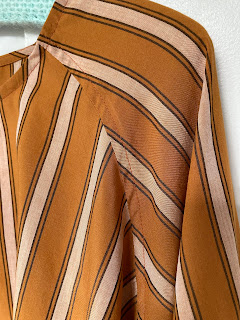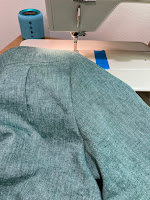I like sewing shirts! And making this Liesl and Co Classic Shirt for a third time was fun. See my earlier makes here.This was an opportunity to lift my game. The fabric was beautiful; yarn dyed, laundered, linen cotton which was soft and also held creases and was easy to ‘finger press’ for those small details during construction.
Examining the fit of my previous Classic Shirts, I made narrower cuffs this time. This shortened the sleeve length which is better. I also lowered the dart and the pockets, just by an inch. In 2022 I had planned and written about sizing down, but actually stayed with size 12.
I added tabs so I can roll the sleeves up. These tabs did not work where I locate them to start with. They lined up with the sleeve placket opening, and were set too low. It was a small adjustment to move them closer to the front, and lift them. It is a nice detail.For the collar construction I referred to two posts, Four Square Walls and Closet Core. These show a different order for assembly. I think I should have used hand stitching to the inside facing to control the result. In my research I also found this great Tilly and the Buttons ten tips.
Then I had a wee diaster. Feeling confident, it was all going well, I did the sleeve plackets, managing to sew them on the wrong side of the sleeve, and back to front! Arghhh. My immediate plan was just to live with these back to front plackets. There is not a lot of difference between the right side and the wrong side of the fabric either which was helpful. Does anyone else do this rationalisation? So I continued on the baste the tucks, and sew the sleeve seam.
Then I did a little research, and found two fantastically helpful guides. I loved Helen’s Closet Patterns and Itch to Stitch’s guide (with helpfully helpfully different fabrics for the three pieces) to sleeve plackets. Particularly the Itch to Stich where there is emphasis on checking right side/wrong side, and a helpful tip to check the small placket is on the skinny/small side of the slit, and the large placket, with the house top, is on the large side. So very helpful, I got it! Research always pays off really, is what I am learning. My final help on the placket was this great post from Off the Cuff which showed beginning the placket top stitching at the bottom of the ‘house’. It also explained so clearly the importance of capturing the small clipped triangle with this first line of stitching.
Soooo I unpicked. The sleeve seams, the tucks, the top stitching, and then finally, after a wee pause, I carefully unpicked, stitch by stitch, the original joining seam between the sleeve and the placket. Now this seam is sewn first and then clipped, risky territory to be undoing this. I applied small square of interfacing over this clipped end, to the wrong side. Then I cut the new plackets 1cm longer. Well I actually cut eh new placket to the pattern, then I remember my plan and cut them again with the extra. Good thing this is a small piece. Now I had the wonderful instructions to follow, and I put it all back together.
Inserting the sleeves was a dream. I like to sew up the sleeve seam and the shirt side seam, then insert the sleeve. I use a hand sandwich technique I learned in a sewing class 25 years ago.
Never any gathering thread, and only a few pins. I keep the shirt body on top, and with my hand in between the shirt and sleeve fabric gently ease the fuller sleeve fabric into the machine.
I was surprised at how quickly this shirt came together. This makes me realise thinking a particular make is 'complex', or ‘big’ can deter me. Perhaps I can change the way I approach my sewing. Actually I enjoyed all the small steps; pocket assembly, the ‘burrito method’ for the yoke etc.
One of my current goals is to make better fabric choices. This was a certainly success in this regard. I also want to sew clothes which I wear. I did an analysis of my wardrobe, looking at what I own, versus what I wear, by ‘activity’, e.g. work, weekend, exercise. This highlighted I would like more casual clothes. Different to work clothes, which do dominate my hangers, and previous sewing. This shirt ticks the 'casual' box; I have worn it to work, but I wear it out with friends, or to the supermarket, and feel good doing so.







































